
The LPG shipping market in 2001 (2)
|
|
|
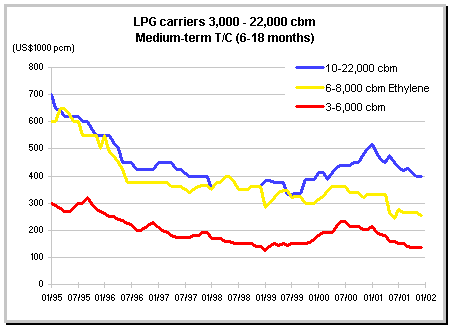
|
Mainly dedicated to the chemical gas
market, and although partially concentrated in the hands of one Major
operator, this sector has been particularly hard hit by the general
decline in consumption and demand for chemical gases. The ethylene,
propylene, butadiene, and vcm markets have all been subject to the
pressure on prices mainly due to a surge in alternative products
upstream (polyethylene, polypropylene, etc.) feed by new production
units in Saudi Arabia, Asia, NAFTA, and due to the
"debottlenecking" of European crackers whose production has
been optimised to be able to compete with units over one million ton
capacity. Numerous ships of 15,000 to 22,000 cbm not finding any regular
employment in chemical gas have had to change sectors and secure voyages
in butane/propane, often at very competitive rates compared to the
bigger size ships. The results in monthly time charters has been to see
a slide in rates throughout the year, going from an average level of
$500,000 at the beginning of the year to $350,000 / 375,000 at mid
December. Nineteen ships are currently on order or under construction in
this size range, including four pressurised ships from 8,300 cbm to
10,500 cbm, and 11 ethylene carriers from 8,200 cbm to 10,000 cbm, all
for delivery in 2002 and 2003. We still have to see a major improvement
in the chemical sector or else a substantial move of older ships into
scrap, to allow this new capacity a chance of getting smoothly absorbed
over the next years!
|
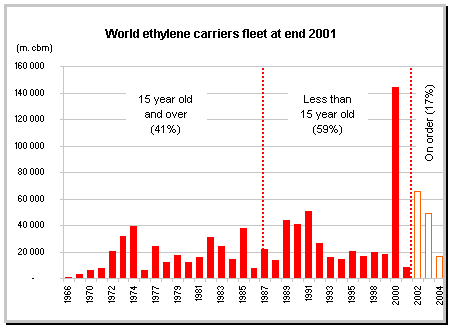
|
|
| Gas
carriers: 8,000 cbm and less
|
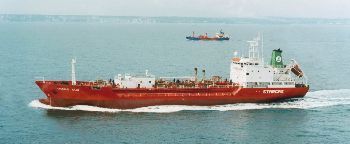 |
Emerald Star
7,464 cbm ethylene carrier, blt 1992 by I.N.M.A., owned by Stargas and operated by the Gaschem-Medgas pool |
|
|
|
A very difficult year as well for this size of gas carrier, given the
slowdown in the petrochemical market and butane/propane trading, as
already intimated. Although even more spread out between numerous
owners, traders/owners and pools, this fleet has been subject to various
buying moves or regroupings between some owners and owning groups
(Lauritzen Kosan, Kilgas, Tschudi & Eitzen) looking for a size
concentration in the marketing of these ships. The spread in the freight
rate levels according to size has been considerably narrowed and falls
in a bracket between $150,000 to $250,000 given actual sizes and
specifications (fully pressurised, semi-pressurised/refrigerated, or
ethylene carrier). The large variations in rates has sometimes permitted
the renewal or extension of some term contracts at floor prices for
periods between six months to one year, as certain owners prefer to
secure an employment at lower numbers rather than tempt an unpredictable
spot market, even in winter.
Newbuildings are also present in this sector with some fifteen ship
on order between 3,000 and 7,500 cbm, pressurised,
semi-pressurised/refrigerated, and ethylene types, all for delivery
between 2002 and 2003.
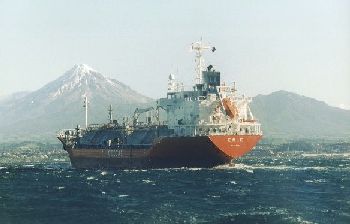 |
Eole
7,216 cbm pressurised,
blt 2000 by Murakami Hide, owned by Tachibanaya and long-term chartered by Geogas |
|
| Perceptions
|
|
|
|
The extent of the slowdown has not spared any
corner of the world and the recent bursting of several economic bubbles
frequently inflated "virtually" may be the price to be paid in
order to go back to the solid foundation on which markets can find a
proper footing.
This lean period with the marketing of products and the operating of
ships pushed down to levels of operating/production costs cannot last too
long except at the risk of seeing the closure of some production sites and
partial or full lay-up of ships.
We should however see in the near future a return to a better balanced
freight market since advances in the supervision and the technical
monitoring of ships, still too often dispersed and haphazard, are
beginning to have a clearer impact on more and more geographical sites.
New restrictions for higher quality put in place by more and more
operators are being tightened and this unavoidable trend should accelerate
the pace of the oldest units being sold to scrap, even for some of them
when well looked after, and thus reduce the surplus capacity affecting
certain size categories of ships.
| LPG
second-hand market |
|
|
LPG carriers over 50,000 cbm
In contrast to previous years, potential buyers in 2001 were able to
profit from the willingness of certain owners to leave this sector or else
to refinance themselves. In this vein there was the sale of the ‘Baltic
Flame', 76,000 cbm delivered in 1992, for $42 million which signalled
the return of Westfal-Larsen back into LPG. By way of comparison the last
sale of a recently built VLGC took place in 1996 when a five-year-old ship
got a price of close to $50 million.
For an older vessel (1981) such as the ‘La Forge' a price of around
$18 million was agreed between MC Shipping and Geogas, with a reserve that
the latter guarantee the ship's employment for five years.
After buying the ‘Darwin' 70,000 cbm built in 1977, for $5 million,
which had been used for a number of years as floating storage, Trafigura
took a commitment to take over the ‘Al Bida' and the ‘Al Berry'
75,000 cbm built in 1979 as a three years bareboat with an obligation to
buy at a price which is understood to be equivalent to $8 million each for
a straight cash sale.
|
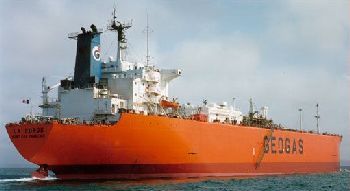 |
La Forge
70,793 cbm, blt 1981 by Nippon Kokan, sold to MC Shipping and chartered back for five years by Geogas |
|
|
20,000 cbm to 50,000 cbm carriers
T here were no sales reported in this category this year, but our
next revue will probably be able to recount the solution which is being
worked on to resolve the problem of the ‘Navigator'. As to older
units, they seem reserved solely for the scrapyard, as did the ‘Gaz
Kandla', 26,000 cbm built in 1969.
8,000 cbm to 20,000 cbm carriers
The news of the year is the en bloc purchase by Tanker Pacific of the
six 15,000 cbm ships of AP Moller, built between 1981 and 1984, for a
price of about $77 million, with the ships joining the AP Moller pool
without any guaranteed results on the part of the latter
Carriers less than 8,000 cbm
Due to lack of candidates available for sale at reasonable prices, the
market for small pressurised ships remains at levels comparable to those
of the last three years despite a lowering of freight rates.
Consequently in the 3,000 / 3,500 cbm sector of pressurised vessels,
Formosa Plastics bought units built in the mid 80's for about $2.5
million. Elsewhere Far East Shipping managed to sell the ‘Deneb Gas',
3,300 cbm built in 1991, for $5 million and the ‘Subaru Gas', 3,500
cbm built in 1998, for $7.4 million.
For the semi-refigerated carriers, the only units offered for sale are
near to or over 20 years, and their owners are often obliged to attract
potential buyers by offering extended terms of credit. It was in this
manner that the owners of ‘Prins Philip Willem' and her two sister
ships, of 1,600 cbm built in 1985, were reported sold on the basis of a
bareboat charter for five years, equivalent to a cash price of $2 million
apiece.
|
Shipping and Shipbuilding Markets in 2001
I N D E X
|